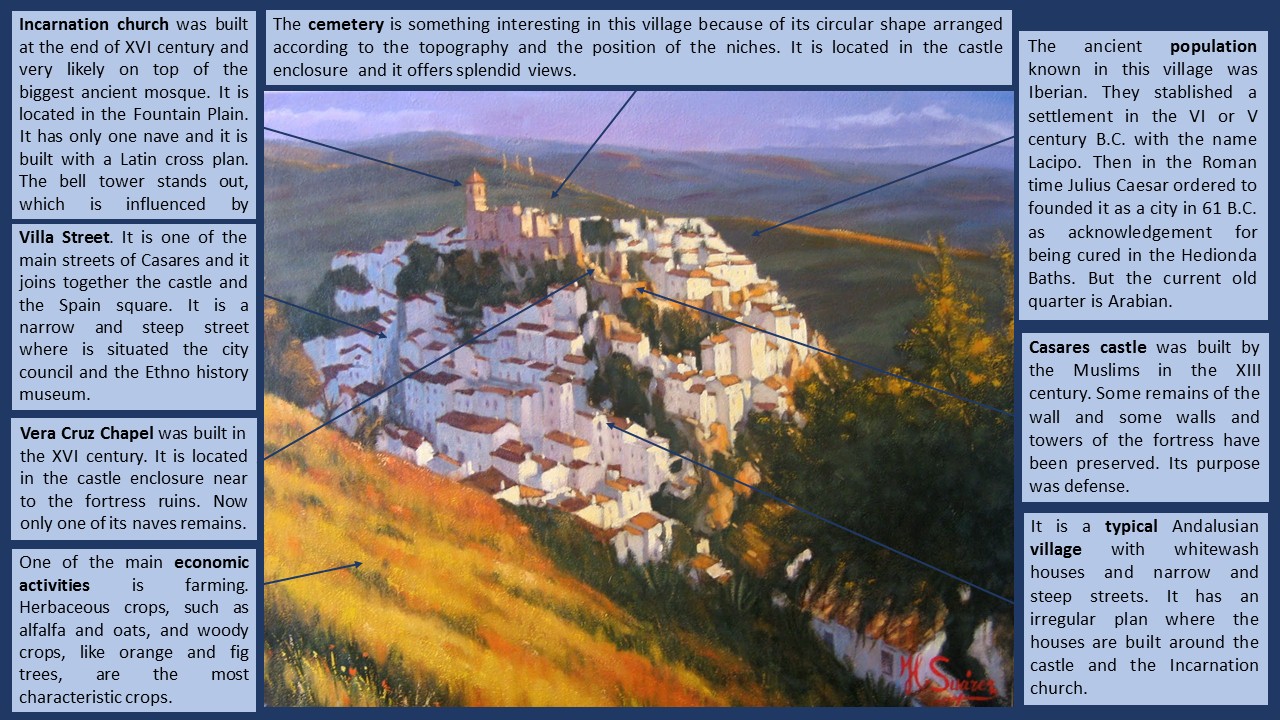This picture was painted by José Luis Suárez in 2009; we can see his signature in the bottom right border pointing out “JL Suárez”. We can find this picture in the personal website gallery of the author. Helena Sassone, art critic, said that José Luis Suárez has an exceed of color and technique in his pictures and it is also remarkable his aesthetic balance. We can observe that he uses dark and light colors to achieve the evening effect that the picture has. She also said that painting landscapes is something that he dominates, as we can see in this picture. The image represents Casares, an Andalusian village in Málaga province. It is located in the end of the Ronda Mountain Range at the top of a hill, which is typical in Muslims settlements as well as a place easy to be defended.
The history of Casares could start 100.000 years ago with Neanderthals, because the place where Casares is located offered good conditions to life for groups of hunters-gatherers. Since 50.000 BC the Homo Sapiens Sapiens occupy this place. It is known that Gran Duque Cave used it as an accommodation place because of the remains that were found such as vessels and personal accessories (bracelets and necklaces). At the end of Prehistory existed in this place some strengthen hamlets. In the III Century BC all the groups that live in this place (Iberian population) joined together and founded a settlement named Lacipo. But Casares was founded as a city in 61 BC when Julius Caesar ordered as acknowledgment for being cured in Hedionda Baths. However, the old quarter is Arabian due to the following invasions.
This is a typical Andalusian village with white wash houses and narrow, steep streets. We can appreciate that the village is built around the Incarnation Church and the castle with an irregular plan, due to the Medieval Muslim influence. Around the village there are crop fields that are economically used for farming. Herbaceous crops, such as alfalfa and oats, and woody crops, like orange and fig trees, are the most characteristic ones.
Concerning the urban layout, Villa Street is one of the main streets of Casares and it joins together the castle and the Spain square. It is a narrow and steep street where is situated the city council and the Ethno History museum. In the center of the village it is the Incarnation Church, Casares Castle, Vera Cruz Chapel and the cemetery. Incarnation Church was built at the end of XVI century and very likely on top of the biggest ancient mosque, located in the Fountain Plain. It has only one nave and it is built with a cross floor. The Arabian influence can be seen in the bell tower, which is influenced by Mudejar art and also, in the castle, which was built in the XIII century by the Muslims with a defensive purpose. Only have been remained some parts of the wall and some walls and towers of the fortress. The wall is an irregular polygon with enterings and projections because of the topography. The cemetery stands out due to its circular shape arranged according to the topography and the position of the niches, it was created in the Visigoth age, it offers splendid views and it is located in the castle enclosure as well as Vera Cruz Chapel, which was built in the XVI century, but now only one of its naves remains.
We should mention that Casares was declared Historical-Artistic complex in 1978 and it is the village where Blas Infante, politician, writer, and the Father of «Andalusianism», was born. Are also remarkable Hedionda Baths, known because of this curative property, its origin is Roman, but they suffer several modifications since its construction. To conclude, I want to highlight that this village is so relevant in history, because of its strategic location. Many civilizations passed through it, leaving each one several contributions to increase the historical and artistic value of this village.
María Rodríguez Colás

